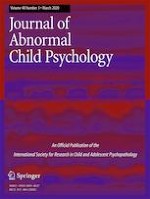04-12-2019
Interpretation Biases and Childhood Anxiety: The Moderating Role of Parasympathetic Nervous System Reactivity
Gepubliceerd in: Research on Child and Adolescent Psychopathology | Uitgave 3/2020
Log in om toegang te krijgenAbstract
This investigation examined vagal modulation of arousal, as indexed by respiratory sinus arrhythmia (RSA), as a moderator of the covariance between interpretation biases and anxiety disorder symptom severity in a diverse sample of clinically anxious youth. A sample of 105 children with anxiety disorders (Mage = 10.07 years, SD = 1.22; range = 8–12 years; 57.1% female; 61.9% ethnic minority) and their mothers completed a battery of measures assessing interpretation biases and anxiety disorder symptom severity. Children also completed a behaviorally-indexed assessment of interpretation biases and participated in an anxiety-provoking speech task. Physiological assessment of RSA was collected at baseline (i.e., baseline RSA) and during the speech task (i.e., challenge RSA). The interaction between challenge RSA and both self-reported and behaviorally-indexed interpretation biases (adjusting for baseline RSA) was significant (ΔR2 = .05 and .04 respectively) in relation to maternal report of child anxiety symptoms. Specifically, among children with low (vs. high) challenge RSA, greater self-reported interpretation biases were significantly associated with maternal report of more severe child anxiety symptoms, and greater behaviorally-indexed interpretation biases were marginally associated with maternal report of more severe child anxiety. Interactions predicting child self-report of anxiety symptoms were not significant. Greater child interpretation biases coupled with lower challenge RSA were associated with maternal report of more severe child anxiety symptoms. Future work should examine whether interventions targeting RSA weaken the association between interpretation biases and anxiety symptoms in youth.
